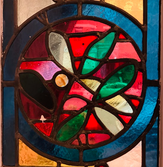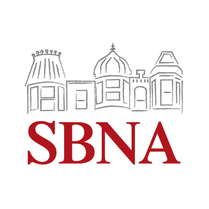About the Stained Glass Project ..
We at SBNA ,and the neighborhood, owe a huge debt of gratitude to our neighbor, Dan dHeilly for all his tireless work bringing this project to light.
From raising awareness of our Stained Glass history, to gathering the information needed to produce and present this fascinating story of stained glass history to the neighborhood. Thank you Dan for the countless hours of lugging around lights , ladders and camera, the endless hours researching and writing content for this project. We'd also like to thank all the neighbors who sent in their beautiful examples of stained glass in their homes and allowed Dan in to photograph their treasured windows. We are in the process of bringing Dan's website onto the SBNA platform. Saint Botolph was "Stained Glass Row"
The Saint Botolph neighborhood saw the manufacture of tens of thousands of stained glass windows from 1913 to 1986 when the Charles J. Connick Associates Studio closed it's doors. They produced over 15,000 windows just for churches and public buildings, and they were not alone.
This was the center of the Arts & Crafts Movement in Boston. The first Arts & Crafts Guild in America was located a couple blocks away on Clarendon Street in 1897. This neighborhood hosted design programs for textiles, cabinetry, ceramics, and other arts, but it was stained glass and book binding that made a home here. This neighborhood also housed stained glass programs for MIT and Boston University a hundred years ago.
Later, Charles J. Connick Associates was one of two nationally renowned stained glass manufacturers located here for more than 75 years For images from Connick Associates click herel
According to Wikipedia.org, Charles J. Connick started his workshop in the Arts & Crafts guild space at 9 Harcourt Street in 1913. Connick’s most notable works include the rose windows of the Cathedrals of St. Patrick and St. John the Divine in New York City, and windows in the American Church in Paris. One of his largest works is in the Heinz Memorial Chapel at the University of Pittsburgh."
Mr. Connick’s work was recognized by Boston University and Princeton University with honorary degrees. Again from Wikipedia [yes, we donated],
"At his death [in 1946], The New York Times reported that Dr. Connick was 'considered the world's greatest contemporary craftsman in stained glass.'"
Today, the front of his studio is still visible next to the SW Corridor Park. It has changed. The top floor used to have a cathedral ceiling where craftsmen could construct large church windows (this was eliminated in a remodel, but the unusual top floor at O'Duggan was modified for the same reason and is still an odd architectural feature).
Twenty years after Charles Connick opened his studio, a second important stained glass company called John Terrence O'Duggan Studio (pronounced Oh Doug In) opened just 4 blocks away at 116 Saint Botolph Street on the corner of Durham Street. So far, we have only been able to confirm two residences with windows from these stained glass manufacturers:
If you can confirm others, please contact us. But it is certain that much of the stained glass in this neighborhood has the fingerprints of the craftspeople who worked with Connick and O'Duggan. |

How to clean your Stained Glass Window!
Did you know we have about 200 stained glass windows that still adorn buildings in the Saint Botolph neighborhood? Dan asked former St. Botolph craftsman Jim Anderson about how to clean stained glass windows, and his answer surprised him." I didn't realize that stained glass windows need repair every hundred years or so!" Dan reported. After windows are finished and the leading soldered, most craftsmen apply a linseed-based grout to both sides of each pane to make it waterproof. Grout naturally dries and crumbles after 70-110 years, and needs repair. How you clean the window impacts the useful life of your grout! Jim related that he cleans the new grout off with sawdust and whiting, then waits for it to dry. Then to eliminate streaks, he uses a little Windex misted onto a rag-free clothe. With old windows, he uses as little water as possible, “Mist a little Windex onto a paper towel and clean each pane separately, but avoid wetting the grout. Whatever you do, don’t spray cleaner onto the stained glass window!” If your windows need repair or you are interested in commissioning a new window, Jim's workshop is on Tremont Street in the South End. Jim worked for the big St Botolph firms when he was learning his craft. A New Neighborhood: 1880-1900
The Saint Botolph neighborhood unfolded one parcel at a time from 1880-1990, as the development of Back Bay moved west from Copley Square towards Massachusetts Avenue.
The first auction of fill land was in 1880. They offered lots on West Newton from the SW Corridor Park (then a railroad crossing into the new landfill) to Saint Botolph (which was already paved). The South End was a fine neighborhood, so this West Newton "extension" offered new homes next to a desirable address. It seems that all townhouses on of West Newton Street were built with stained glass, but several have none today, and records are hard to find, so who can say? The next parcels developed were west one block on Saint Botolph Street, then south onto Durham Street. By 1882, the neighborhood was settled in a horseshoe pattern. Most townhouses on Durham have stained glass.
The other St. Botolph Street parcels auctioned in the early 1880s were close to Mass Avenue. The north side of the street was developed to Blackwood. These two blocks also have some outstanding stained glass displays (see 171 and 199) By the mid-1880s, both sides of St. Botolph were developed from Durham Street west to Cumberland Street, and east from West Newton to Fallon Street. Except for Durham, side streets featured less impressive stained glass than Saint Botolph and West Newton Streets.
The last stretch of Saint Botolph Street developed was the south side from Albemarle to Cumberland Street. That area was developed after 1890, and mostly in the Neo-classical architectural style. The color of the brick changed from red to white or yellow, details became symmetrical, and we have found no stained glass from the original construction on either street Most of the best stained glass windows are on Saint Botolph, West Newton, and Durham Streets (ie, 132 West Newton and 109 St. B). The Saint Botolph Neighborhood

Throughout the neighborhood, real estate developers tended to mark their properties with a unique stained-glass signature. (About 150 of the original street addresses remain from 1900 when the original development was complete.) Probably the best example of this is from 124 to 132 St. Botolph where townhouses built by the same developer all feature the same lovely window beside the front door (we may document the developers if folks are interested).
Developers would pick a stained glass pattern, then repeat it (often with some variation) in all the townhouses they built. Once you notice this phenomenon, you will see it repeated throughout the neighborhood: there are many groups of 4-7 townhouses that share architectural styles and stained glass window motifs. Usually, they also share roof designs and other features. Identifying developer patterns in St. B can make for an entertaining game. By 1900, this neighborhood was developed, and ready for a multi-use future with light industrial, conference halls, apartments, and single family brownstones mixed into an 8x2 block space. Everything built before 1890 seems to have had stained glass.
|
Location |
You can find News & Updates at our bulletin board outside the 7-Eleven at the corner of Saint Botolph and West Newton Street. |
|




